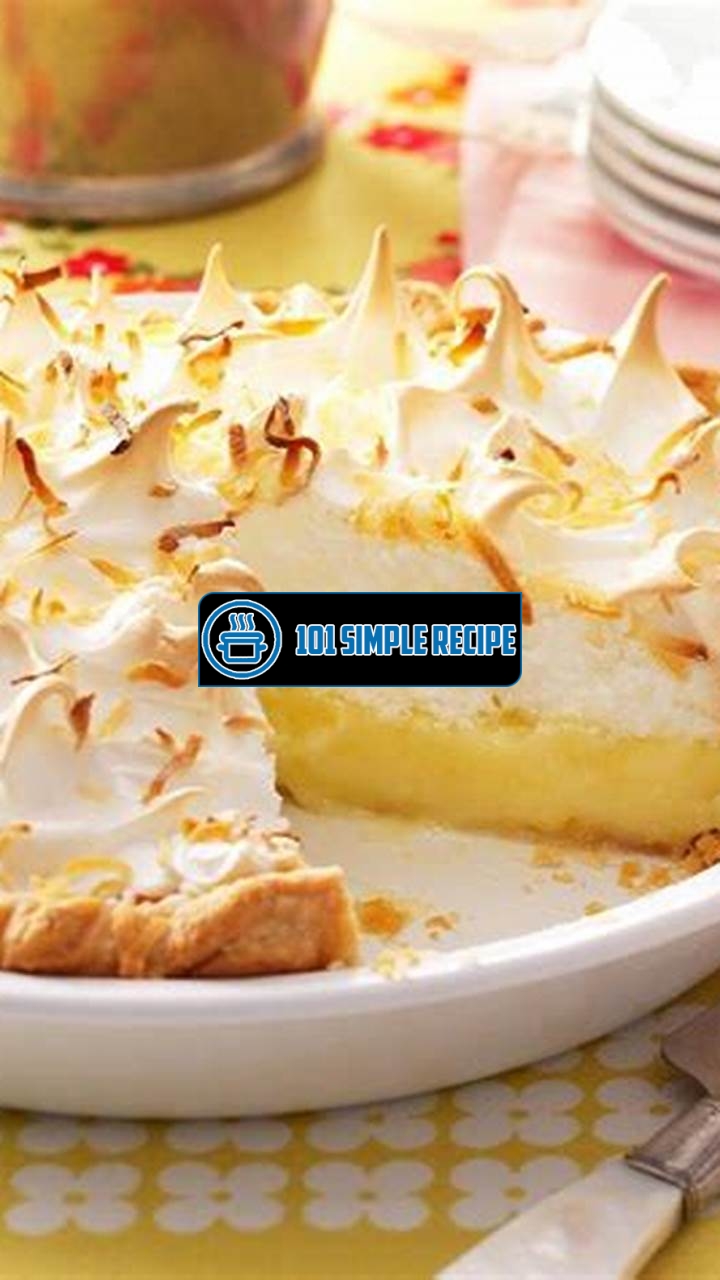Are you craving a delicious and indulgent dessert? Look no further than this mouthwatering coconut cream pie recipe with a fluffy meringue topping. This recipe combines the creamy goodness of coconut with a light and airy meringue, resulting in a dessert that is sure to impress. Whether you’re hosting a dinner party or simply treating yourself to a sweet treat, this coconut cream pie is the perfect choice. With its decadent flavors and beautiful presentation, it’s bound to become a favorite in your household. Put on your apron and get ready to bake up a slice of paradise!

Understanding the Coconut Cream Pie Recipe with Meringue
When it comes to desserts, few can match the pure decadence of a coconut cream pie with fluffy meringue topping. This classic dessert offers a delightful combination of flavors and textures that is sure to please even the most discerning palates.
The History of Coconut Cream Pie
Coconut cream pie has a rich history that spans back many years. It is believed to have originated in the Southern United States, where coconuts were readily available due to the region’s warm climate. Over time, the recipe for coconut cream pie has evolved and been passed down through generations, with each cook adding their own unique twist.
One popular theory regarding the origins of coconut cream pie is that it was inspired by the traditional English custard pie. However, instead of using traditional dairy-based custard, coconut milk and cream were used to create a more tropical flavor profile. This combination was an instant hit, and coconut cream pie quickly became a beloved dessert in households across the country.
The Role of Meringue in Coconut Cream Pie
The fluffy meringue topping is a key component of coconut cream pie. It adds not only a visually appealing element but also a light and airy texture that complements the creamy coconut filling perfectly. The meringue is made by whipping egg whites and sugar together until stiff peaks form. This mixture is then spread over the coconut cream filling and baked until golden brown.
The meringue not only enhances the taste and texture of the pie but also helps to protect the silky coconut cream from drying out. Its light, airy qualities provide a gentle barrier that keeps the filling moist and creamy. Plus, who can resist that beautiful toasted meringue topping?
Choosing the Perfect Coconut
When it comes to selecting the best coconut for your pie, there are a few options to consider. The most common types of coconuts used in cooking are young coconuts and mature coconuts.
Young coconuts, also known as Thai coconuts or baby coconuts, have a green outer shell and contain a significant amount of coconut water. They are often used in dishes where the focus is on the liquid rather than the meat. However, for a coconut cream pie, it is best to choose a mature coconut.
Mature coconuts have a brown, hairy outer shell and contain a thicker, richer, and more flavorful coconut meat. This type of coconut is ideal for extracting both the cream and the meat needed for the pie filling. When selecting a mature coconut, look for ones that feel heavy for their size and have a slight swishing sound when shaken, indicating that they are full of delicious coconut water.
So, whether you’re a fan of the classic coconut cream pie or looking to try it for the first time, understanding the coconut cream pie recipe with meringue is key. The combination of the creamy coconut filling, fluffy meringue topping, and the perfect coconut selection creates a dessert that is truly irresistible.
Coconut cream pie recipe is a delicious dessert that you can make at home. It’s made with coconut cream, meringue, and a flaky pie crust.
The Art of Making a Flaky Crust
Mastering the art of making a flaky pie crust is essential when creating a delicious coconut cream pie with a fluffy meringue topping. The crust serves as the foundation for the creamy filling, providing a buttery and delicate texture that perfectly complements the other flavors. With a few simple steps, you can create a crust that will impress your family and friends with its flakiness and taste.
Key Ingredients for the Crust
To achieve the perfect texture and taste for your crust, you’ll need a few key ingredients:
- All-Purpose Flour: This is the main ingredient for the crust, providing structure and stability.
- Unsalted Butter: The butter adds richness and flavor to the crust. Make sure it is cold and cubed for the best results.
- Ice Water: Cold water helps bind the dough together without melting the butter. It’s important to use ice water to keep the butter cold.
- Salt: Salt enhances the flavor of the crust and balances the sweetness of the filling.
Step-by-Step Crust Preparation
Follow this detailed guide to prepare the dough, roll it out, and bake it to perfection:
- Combine the Ingredients: Start by combining the flour and salt in a large bowl. Add the cold, cubed butter and use a pastry cutter or your fingers to cut it into the flour until the mixture resembles coarse crumbs.
- Add the Ice Water: Gradually add the ice water, a tablespoon at a time, and mix it into the flour mixture using a fork. Keep adding water until the dough just comes together. Be careful not to overmix, as this can result in a tough crust.
- Form the Dough: Gather the dough into a ball, then lightly knead it on a floured surface until it becomes smooth. Shape it into a disk, wrap it in plastic wrap, and refrigerate it for at least 30 minutes.
- Roll Out the Dough: After the dough has chilled, remove it from the refrigerator and let it sit for a few minutes to soften slightly. Roll it out on a floured surface, starting from the center and working your way out, until it reaches the desired size for your pie dish.
- Transfer and Crimp: Carefully transfer the rolled-out dough to your pie dish. Trim any excess dough hanging over the edges and use your fingers or a fork to create a decorative crimp along the rim.
- Pre-Bake (Blind Bake) the Crust: To prevent a soggy crust, you can pre-bake it before adding the filling. Line the crust with parchment paper and fill it with pie weights or dried beans. Bake it in a preheated oven for about 15 minutes, then remove the weights and parchment paper and bake for an additional 5 minutes to ensure the bottom is fully cooked.
Troubleshooting Common Crust Issues
While making a crust can be straightforward, sometimes issues can arise. Here are some expert tips to troubleshoot common problems:
Soggy Crust: If your crust is consistently turning out soggy, try brushing a thin layer of beaten egg white onto the crust before adding the filling. This creates a barrier and helps prevent moisture from seeping into the crust.
Shrinkage: If your crust shrinks during baking, make sure to roll it out larger than the size of your pie dish. This allows for some shrinkage without compromising the crust’s overall appearance and texture.
By mastering the art of making a flaky pie crust, you can elevate your coconut cream pie with meringue to a whole new level of deliciousness. Just remember to follow the steps carefully, use the right ingredients, and troubleshoot any common crust issues that may arise. Enjoy!
Weight loss recipe can help you achieve your fitness goals. It includes healthy ingredients that promote weight loss and provide essential nutrients.
Preparing the Decadent Coconut Cream Filling
Uncover the secrets to creating a luscious coconut cream filling that is both smooth and flavorful.
Essential Ingredients for the Filling
Discover the key components that give the filling its creamy texture and rich coconut taste.
When it comes to making a delicious coconut cream pie, the filling is the star of the show. To achieve a luscious and flavorful result, it’s essential to use the right ingredients. Here are the key components that will give your coconut cream filling its creamy texture and rich coconut taste:
- Coconut Milk: Start with high-quality coconut milk to ensure a good base for your filling. Look for cans labeled “full-fat” or “classic” coconut milk to get the creamiest consistency.
- Full-Fat Milk: Adding a bit of full-fat milk helps to balance the richness of the coconut milk and creates a smooth and creamy texture.
- Sugar: Sweeten the filling with granulated sugar to enhance the flavor. Adjust the amount according to your preference.
- Cornstarch: Cornstarch is the secret ingredient that thickens the filling and gives it that perfect, pudding-like consistency.
- Egg Yolks: Whisking in egg yolks adds richness and helps to thicken the filling even further. Be sure to whisk them well before incorporating into the mixture.
- Vanilla Extract: A dash of vanilla extract adds a lovely aroma and enhances the overall flavor of the coconut cream filling.
- Butter: To add a silky richness to the filling, a small amount of butter can be melted and stirred in at the end.
By using these essential ingredients, you’ll be well on your way to creating a decadent coconut cream filling that will impress your friends and family.
Cooking and Thickening the Filling
Follow a step-by-step process to heat and thicken the filling, ensuring a perfect consistency every time.
Now that you have gathered all the necessary ingredients, it’s time to cook and thicken the filling to achieve the perfect consistency. Here’s a step-by-step process to guide you:
- Combine the ingredients: In a saucepan, whisk together the coconut milk, full-fat milk, sugar, and cornstarch until well combined.
- Cook over medium heat: Place the saucepan over medium heat and bring the mixture to a gentle boil, stirring constantly to prevent lumps from forming.
- Thicken the filling: Reduce the heat to low and continue to cook the mixture for a few minutes until it thickens into a creamy consistency. Keep stirring to ensure even cooking.
- Temper the egg yolks: In a separate bowl, whisk the egg yolks. Gradually add a small amount of the hot coconut mixture to the egg yolks while whisking continuously. This step helps prevent the eggs from curdling when added to the hot mixture.
- Combine the mixtures: Pour the tempered egg yolks into the saucepan with the coconut mixture. Stir well to combine.
- Cook until thickened: Return the saucepan to low heat and cook the mixture for a few more minutes until it reaches a thick and pudding-like consistency. Stir constantly to prevent scorching.
- Remove from heat and add butter: Once thickened, remove the saucepan from heat and add the butter. Stir well until the butter melts and incorporates into the filling.
Following these steps will result in a perfectly cooked and thickened coconut cream filling, ready to be poured into your pie crust.
Enhancing the Flavor with Coconut
Learn how to infuse your filling with additional coconut flavor for an intensified taste experience.
While the coconut milk forms the base of the filling, there are additional ways to enhance the coconut flavor for a truly indulgent experience. Here are some tips to infuse your filling with extra coconut goodness:
- Toast the coconut flakes: Before adding the coconut flakes into the filling, toast them in a dry skillet over low heat until golden and fragrant. This simple step intensifies their flavor and adds a delightful crunch.
- Add coconut extract: Boost the coconut flavor by adding a few drops of coconut extract to the filling. This concentrated extract will give your pie an extra burst of coconut essence.
- Garnish with toasted coconut: Sprinkle some toasted coconut flakes on top of the meringue or whipped cream topping before serving. The toasted flakes not only add visual appeal but also provide an extra pop of coconut flavor.
By incorporating these additional coconut-infused elements, you’ll take your coconut cream pie to the next level of deliciousness.
A Perfectly Toasted Meringue Topping
In order to create a magnificent coconut cream pie, one of the most essential elements is the meringue topping. This golden, fluffy layer is what sets this dessert apart from others. Mastering the technique of creating a perfectly toasted meringue topping will elevate your pie to a whole new level of deliciousness.
Choosing the Right Egg Whites
When it comes to making a successful meringue, fresh eggs play a crucial role. Fresh eggs have tighter proteins, which allows for better stability and volume when beating the egg whites. The proteins in older eggs tend to be more relaxed, resulting in a weaker meringue. So, always opt for the freshest eggs you can find for the best results.
Separating the egg whites from the yolks can be a delicate process. Any trace of yolk in the whites can interfere with the ability of the proteins to bond together and create the desired airy texture. Crack each egg into a separate bowl before adding the whites to your mixing bowl. This way, you can ensure that if a yolk accidentally breaks, it doesn’t contaminate the entire batch of egg whites.
Whipping and Sweetening the Meringue
Whipping the egg whites to the perfect consistency is key to achieving a light and fluffy meringue. Begin by using an electric mixer on medium speed, and gradually increase to high speed once the bubbles begin to form. You will notice that the mixture becomes thicker and glossier.
At this point, it’s time to add the desired amount of sweetness. It is recommended to gradually add the sugar while continuing to beat the egg whites. This will allow the sugar to dissolve completely and incorporate evenly into the mixture. Adding the sugar too quickly can result in a grainy texture. Use a standard granulated sugar for a classic taste, or experiment with alternative sweeteners for a unique twist.
Baking and Browning the Meringue
Once the meringue is perfectly whipped and sweetened, it’s time to bake it on top of the coconut cream pie. Preheat your oven to 350°F (175°C) to ensure even baking. Gently spread the meringue over the pie filling, starting from the edges and working your way towards the center. Make sure to completely cover the filling with an even layer of meringue.
To achieve that beautifully browned meringue with a slightly crispy exterior, it’s important to pay attention to the baking time and temperature. Place the pie on the middle rack of your oven and bake for about 15-20 minutes, or until the meringue turns a golden brown color. Keep a close eye on it to avoid over-browning or burning.
Once the pie is done baking, remove it from the oven and allow it to cool before serving. This will allow the meringue to set and firm up, making it easier to slice and serve. ️
By following these techniques and mastering the art of creating a perfectly toasted meringue topping, you can create a coconut cream pie that will impress your family and friends. So, gather your ingredients, preheat that oven, and get ready to indulge in a slice of pure dessert perfection!
White Castle recipe is a favorite fast food burger that you can recreate at home. It features a small, square patty with onions and pickles.
Serving and Storing Your Coconut Cream Pie
When it comes to presenting and preserving your delightful coconut cream pie, there are some best practices to keep in mind. By following these guidelines, you can ensure that your creation looks and tastes its best.
Garnishing and Presentation Ideas
One of the most exciting aspects of preparing a coconut cream pie is the opportunity to get creative with garnishing and presentation. Let your imagination run wild and impress your guests with these ideas:
- Fresh Fruit Toppings: Add a burst of color and freshness to your coconut cream pie by garnishing it with a selection of fresh fruits. You can use sliced strawberries, blueberries, or even tropical fruits like mango and pineapple to create a visually appealing presentation.
- Whipped Cream Designs: Elevate the look of your pie by using whipped cream to create decorative designs. You can use a piping bag with different tips to make swirls, rosettes, or even write personalized messages on the pie’s surface. This adds an extra touch of elegance and sophistication.
- Chocolate Drizzle: For all the chocolate lovers out there, consider adding a drizzle of melted chocolate over your coconut cream pie. This not only adds a rich and indulgent flavor but also makes the presentation more visually appealing.
Preserving the Pie’s Freshness
Properly storing your coconut cream pie is crucial to maintain its freshness and flavors. Here are some tips to help you in this regard:
- Refrigeration: After your pie has completely cooled, cover it with plastic wrap or place it in an airtight container. Store it in the refrigerator to keep it fresh for an extended period. Remember to remove it from the fridge around 20 minutes before serving to allow it to come to room temperature.
- Individual Containers: If you are serving individual portions of coconut cream pie, consider using small, sealable containers. This will prevent any air exposure and help maintain the pie’s texture and taste.
- Freezing: In case you want to preserve your coconut cream pie for a more extended period, you can freeze it. Wrap the pie tightly in plastic wrap and then place it in a freezer-safe container. Thaw it in the refrigerator a day before serving and allow it to come to room temperature before enjoying.
Serving Suggestions and Pairings
While a coconut cream pie is delicious on its own, you can take its flavors to the next level by pairing it with suitable beverages and accompaniments. Here are some serving suggestions:
- Coffee or Espresso: The rich and creamy flavors of coconut cream pie complement the bitterness of coffee or espresso perfectly. The contrast creates a delightful taste experience that will satisfy any coffee lover.
- Vanilla Ice Cream: Serve a slice of coconut cream pie with a generous scoop of vanilla ice cream for a classic dessert combination. The coolness of the ice cream pairs harmoniously with the creamy texture of the pie.
- Fruit Salad: For a lighter and refreshing pairing, serve your coconut cream pie with a side of fresh fruit salad. The acidity and natural sweetness of the fruits will balance the richness of the pie.
By following these serving suggestions and pairing ideas, you can create a memorable dessert experience for your guests.
Frequently Asked Questions
If you have any doubts or questions about this coconut cream pie recipe with meringue, we’ve got you covered. Take a look at some commonly asked questions below:
| No. | Questions | Answers |
|---|---|---|
| 1. | What type of coconut should I use for the recipe? | You can use either sweetened or unsweetened shredded coconut, depending on your preference. Sweetened coconut will add a hint of sweetness to the pie, while unsweetened coconut will provide a more natural flavor. |
| 2. | Can I use store-bought crust instead of making my own? | Yes, you can use a pre-made crust if you prefer. Just make sure it fits the pie dish and follow the same baking instructions. |
| 3. | Can I substitute the meringue with whipped cream? | Certainly! If you’re not a fan of meringue, you can substitute it with whipped cream. Just spread a layer of whipped cream on top of the pie before serving. |
| 4. | How long does the pie need to cool before serving? | It’s best to let the pie cool for at least 2 hours before serving. This will allow the filling to set and the flavors to come together. |
| 5. | Can I make the pie in advance? | Absolutely! You can make the pie a day in advance and store it in the refrigerator. Just hold off on adding the meringue until right before serving. |
| 6. | How long will the pie stay fresh? | The pie will stay fresh in the refrigerator for up to 3 days. Make sure to cover it tightly with plastic wrap or place it in an airtight container. |
Thank You for Reading, and Enjoy Your Delicious Coconut Cream Pie!
We hope you’ve enjoyed reading this mouthwatering coconut cream pie recipe with meringue. It’s the perfect dessert to wow your family and friends. Remember, if you ever crave the creamy, coconutty goodness, simply visit our website again for more delectable recipes. Happy baking!
Jump to Recipe
Coconut Cream Pie with Meringue

Indulge in the creamy and coconutty goodness of this coconut cream pie with meringue. It’s a perfect dessert to satisfy your sweet tooth.
- 1 pre-made pie crust
- 1 1/2 cups sweetened shredded coconut
- 2 3/4 cups milk
- 3/4 cup white sugar
- 1/3 cup all-purpose flour
- 1/4 teaspoon salt
- 3 egg yolks (beaten)
- 2 tablespoons butter
- 1 teaspoon vanilla extract
- 3 egg whites
- 1/4 teaspoon cream of tartar
- 1/4 cup white sugar
- Preheat the oven to 350°F (175°C).
- Line a 9-inch pie dish with the pre-made crust and bake for 10 minutes, or until lightly golden. Remove from the oven and set aside to cool.
- In a saucepan, combine the shredded coconut, milk, 3/4 cup of sugar, flour, and salt. Cook over medium heat, stirring constantly, until the mixture thickens and comes to a boil. Remove from heat.
- In a separate bowl, beat the egg yolks. Gradually whisk in about 1/2 cup of the hot coconut mixture. This will temper the eggs and prevent them from curdling.
- Pour the tempered egg mixture back into the saucepan with the remaining coconut mixture. Cook over medium heat for an additional 2 minutes, stirring constantly.
- Remove the saucepan from heat and stir in the butter and vanilla extract until well combined. Pour the filling into the baked pie crust.
- In a large mixing bowl, beat the egg whites and cream of tartar until foamy. Gradually add in 1/4 cup of sugar, continuing to beat until stiff peaks form.
- Spread the meringue evenly over the pie, making sure to seal the edges. Use a spatula to create decorative peaks.
- Bake the pie in the preheated oven for 15-20 minutes, or until the meringue is golden brown.
- Remove the pie from the oven and let it cool completely on a wire rack. Once cooled, refrigerate for at least 2 hours before serving. Enjoy!






